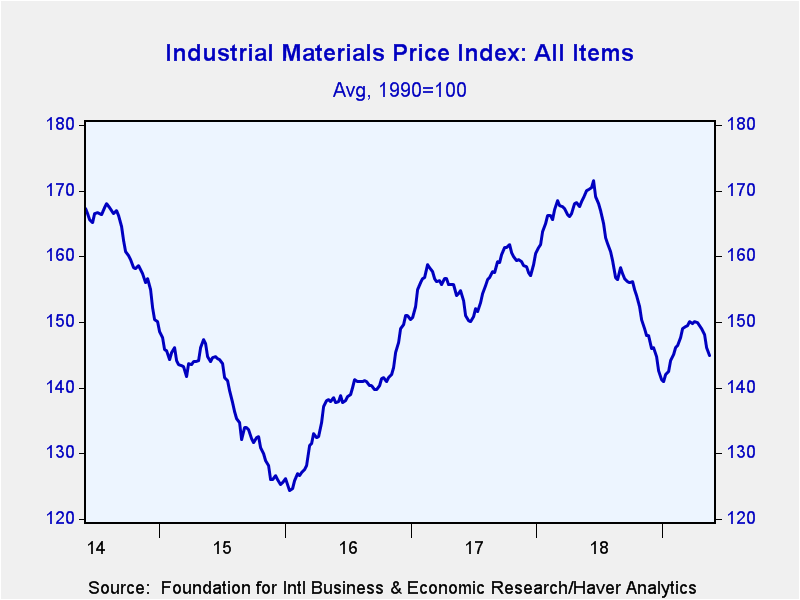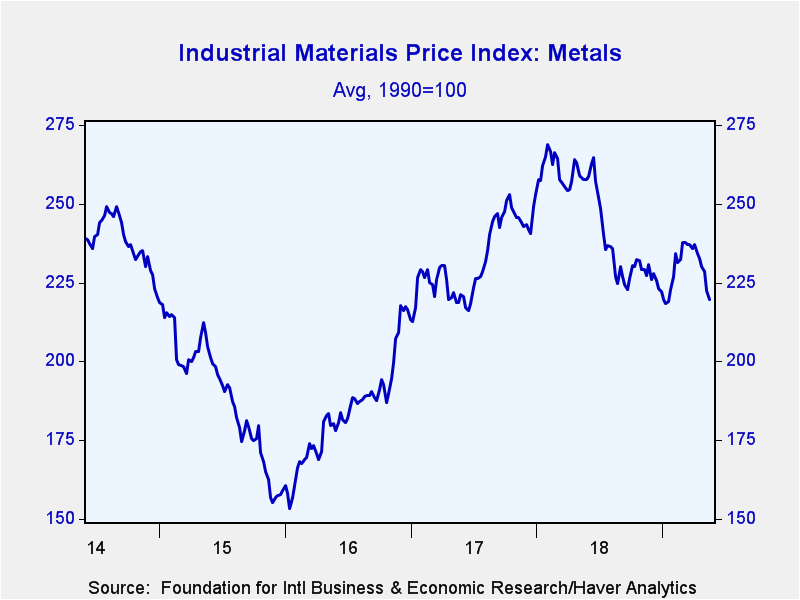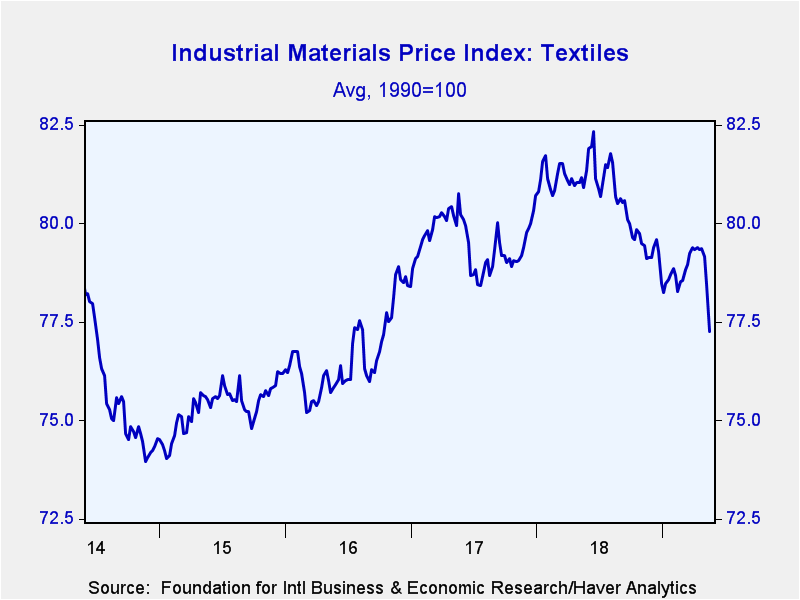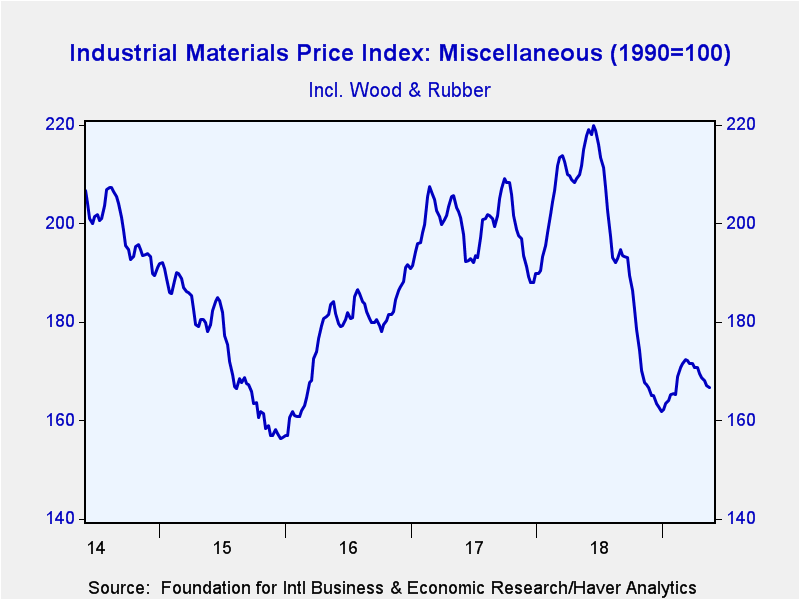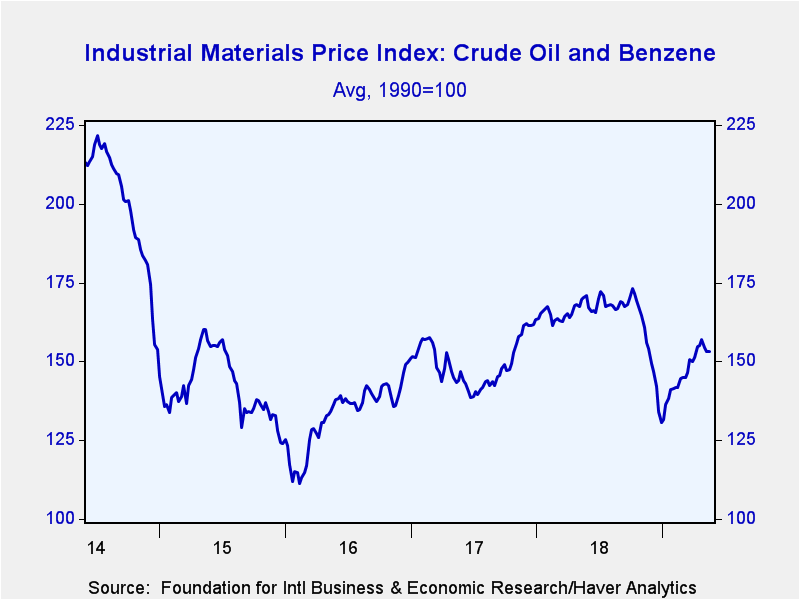 Global| May 20 2019
Global| May 20 2019FIBER: Industrial Commodity Prices Continue Downward
by:Tom Moeller
|in:Economy in Brief
Summary
Last week's report that factory sector output fell again in April helps shed light on the recent weakness in industrial commodity prices. The Industrial Materials Price Index from the Foundation for International Business and Economic [...]
Last week's report that factory sector output fell again in April helps shed light on the recent weakness in industrial commodity prices. The Industrial Materials Price Index from the Foundation for International Business and Economic Research (FIBER) fell 3.0% during the last four weeks, weakened 1.1% during the last three months and dove 14.2% below the prior year's level. Declines were registered across product categories.
Metals prices fell 5.7% over the last month, reflecting a 6.6% decline in steel scrap prices. Zinc prices also weakened 6.9% during that period and were 10.4% lower y/y. Copper scrap prices declined 6.4% m/m, while aluminum pries eased 2.7%. Lead prices also dropped sharply. Prices in the textile group fell 2.6% during the last four weeks paced by a 15.2% decline in cotton prices. Some of that extreme weakness was tempered by a just a slight m/m easing in burlap prices, which were down 3.9% y/y. Prices in the miscellaneous group were off 1.7% m/m led by a 6.2% drop in hide prices. They were down by more than one-third y/y. Structural panel prices also declined 2.2% m/m and by 35.2% y/y. Offsetting some of this recent weakness was a modest m/m rise in natural rubber costs and stability in framing lumber prices. A 1.2% m/m price decline in the crude oil & benzene category was led by a 2.6% drop in crude oil prices to $62.22 per barrel, which have since stabilized. Prices remain above the $45.02 low at the end of last year. Despite the latest increase, crude oil prices remained down versus the $75.05 early-October peak. Prices for the petro-chemical benzene declined 1.0% during the last month, and they remained one-quarter below the year-ago level.
Improvement in industrial commodity prices may be forthcoming as the consensus forecast from the National Association for Business Economics (NABE) calls for a 2.8% rise in industrial output during all of 2019 and a 1.7% gain next year. During the last ten years, there has been a 52% correlation between the y/y change in industrial commodity prices and the y/y change in factory sector output.
Commodity price data can be found in Haver's DAILY, WEEKLY, USECON and CMDTY databases. The NABE forecast is in the SURVEYS database.
| FIBER Industrial Materials Price Index (%) | 1-Mth | 3-Mth | 6-Mth | 12-Mth | 2018 | 2017 | 2016 |
|---|---|---|---|---|---|---|---|
| All Items | -3.0 | -1.1 | -2.0 | -14.2 | -12.0 | 6.7 | 19.2 |
| Textiles | -2.6 | -1.3 | -2.3 | -4.5 | -2.8 | 3.0 | 2.8 |
| Cotton (cents per pound) | -15.2 | -6.8 | -15.9 | -23.2 | -9.2 | 9.8 | 10.2 |
| Metals | -5.7 | -5.2 | -3.4 | -14.8 | -12.2 | 18.6 | 32.9 |
| Aluminum ($ per metric ton) | -2.7 | -2.9 | -7.4 | -21.9 | -12.7 | 26.0 | 13.0 |
| Copper Scrap (cents per pound) | -6.4 | -1.6 | -1.0 | -11.3 | -16.1 | 29.3 | 17.3 |
| Steel Scrap ($ per ton) | -6.6 | -11.2 | -12.0 | -14.9 | 2.3 | 16.8 | 74.5 |
| Crude Oil & Benzene | -1.2 | 8.2 | -1.8 | -10.0 | -20.0 | 8.1 | 20.4 |
| Crude Oil (WTI, $ per Barrel) | -2.6 | 16.0 | 8.2 | -12.7 | -24.4 | 10.9 | 44.3 |
| Miscellaneous | -1.7 | -1.4 | -0.4 | -22.5 | -14.8 | -0.5 | 21.7 |
| Framing Lumber ($ per 1000 board ft.) | 0.0 | -4.6 | 6.3 | -35.0 | -23.1 | 20.0 | 12.9 |
| Natural Rubber (cents per pound) | 0.9 | 8.8 | 25.0 | 3.9 | -4.1 | -29.6 | 89.4 |
Tom Moeller
AuthorMore in Author Profile »Prior to joining Haver Analytics in 2000, Mr. Moeller worked as the Economist at Chancellor Capital Management from 1985 to 1999. There, he developed comprehensive economic forecasts and interpreted economic data for equity and fixed income portfolio managers. Also at Chancellor, Mr. Moeller worked as an equity analyst and was responsible for researching and rating companies in the economically sensitive automobile and housing industries for investment in Chancellor’s equity portfolio. Prior to joining Chancellor, Mr. Moeller was an Economist at Citibank from 1979 to 1984. He also analyzed pricing behavior in the metals industry for the Council on Wage and Price Stability in Washington, D.C. In 1999, Mr. Moeller received the award for most accurate forecast from the Forecasters' Club of New York. From 1990 to 1992 he was President of the New York Association for Business Economists. Mr. Moeller earned an M.B.A. in Finance from Fordham University, where he graduated in 1987. He holds a Bachelor of Arts in Economics from George Washington University.


